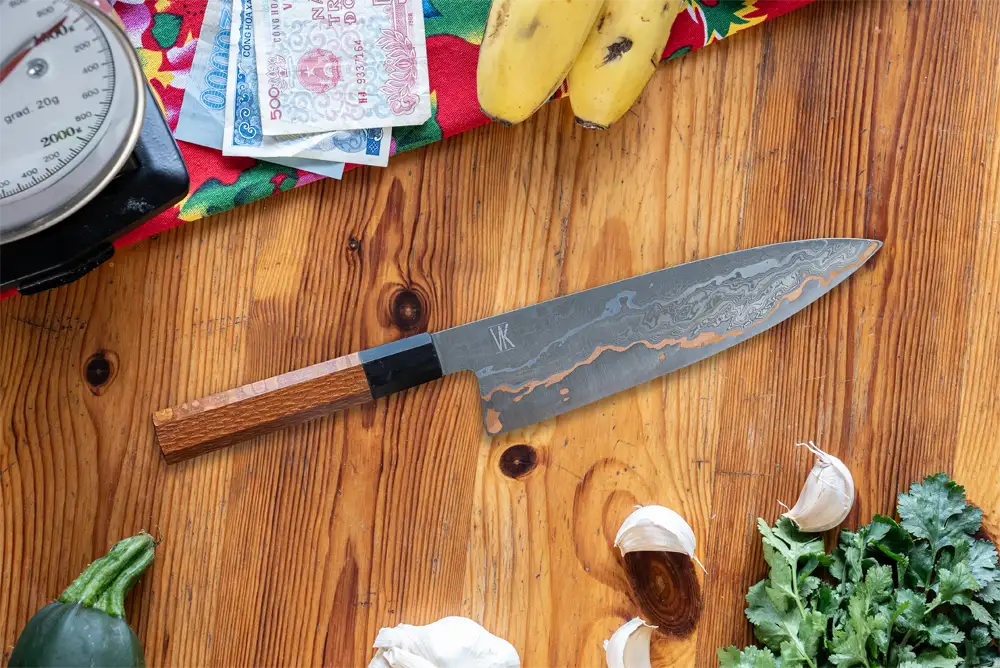For culinary professionals and home cooks alike, the Damascus boning knife stands as a hallmark of quality and precision. It is a tool that marries centuries-old craftsmanship with modern culinary needs. This specialized knife is not only prized for its functionality but also for its unique, eye-catching patterns that speak to its ancient roots. In this blog post, we will delve into the fascinating world of Damascus boning knives, exploring their history, construction, and benefits in the culinary arts.

The Legacy of Damascus Steel
Named after the capital city of Syria, Damascus steel dates back to around 300 AD. Known for its water-like patterns and incredible durability, it was used to create swords and blades famed for their strength and sharpness [source]. Fast forward to today, this legendary material finds its application in modern-day high-quality kitchen knives.
The Unique Pattern of Damascus Steel
The mesmerizing patterns you see on a Damascus boning knife are not just there for show. These patterns are the result of folding different types of stainless steel together. This process not only enhances the knife’s aesthetics but also contributes to its strength and sharpness.
Why Choose a Damascus Boning Knife?
Precision and Control: The thin, flexible blade of a Damascus boning knife allows for precise cuts, making it easier to separate meat from bones without losing any valuable portions.
Durability: Thanks to the unique composition of Damascus steel, these knives are incredibly durable. They maintain their edge longer, requiring less frequent sharpening, which is a boon for any busy kitchen.
Aesthetic Appeal
Beyond its functional benefits, the knife’s aesthetic value is significant. The distinctive wavy pattern on the blade is a conversation starter and a unique addition to any culinary artisan’s toolkit.
How to Choose Your Damascus Boning Knife
When selecting a Damascus boning knife, it’s essential to focus on several aspects:
Blade Material
Look for a knife made with high-carbon stainless steel, ensuring both rust resistance and sharpness retention. The combination provides a blade that is easy to maintain and offers professional-level performance.
Handle Comfort
Equally as important as the blade is the handle’s comfort and grip. Opt for materials that provide a firm, slip-resistant grip, such as ergonomically designed wooden or composite handles.
Size and Flexibility
Consider a flexible blade to easily maneuver around bones and joints, especially if you frequently work with poultry or fish.
Caring for Your Damascus Boning Knife
Maintaining your knife is key to ensuring its longevity and performance. Here are some tips:
Regular Sharpening
Sharpen your knife regularly, but be mindful of the edges. Use a honing steel or professional sharpening service to keep the blade in its best condition.
Proper Cleaning
Hand wash your knife with mild detergent and dry immediately to prevent any unnecessary moisture exposure, which could lead to rusting despite its resilience.
Practical Uses in the Kitchen
With its design geared for deboning, a Damascus boning knife excels in tasks like:
Deboning Chicken and Fish
The knife’s narrow, pointed blade allows chefs to skillfully separate delicate meat from the bone without tearing.
Trimming Fat and Sinew
Its precise design is perfect for trimming excess fat, allowing chefs to create healthier, leaner dishes.
For in-depth tips on preparing meats, including beef shank and stew meat, explore helpful resources like these techniques for expertly finishing your dishes.

FAQs About Damascus Boning Knives
1. Can a Damascus boning knife rust?
While the high-carbon steel provides some rust resistance, it’s always best to dry your knife immediately after washing to prevent any rust.
2. How often should I sharpen my knife?
Regular honing can reduce the need for frequent deep sharpening. However, if used regularly, professional sharpening might be needed every six months.
3. Is a flexible blade necessary?
For tasks that require intricate slicing, such as filleting fish or deboning chicken, a flexible blade is highly advantageous.
In conclusion, a Damascus boning knife is not just a tool but a combination of art and engineering. Its unique construction offers durability, precision, and a stunning aesthetic that enhances any culinary task. Investing in one promises a lifetime of excellent service, making it an invaluable addition to any kitchen.
This article contains affiliate links. We may earn a commission at no extra cost to you.


